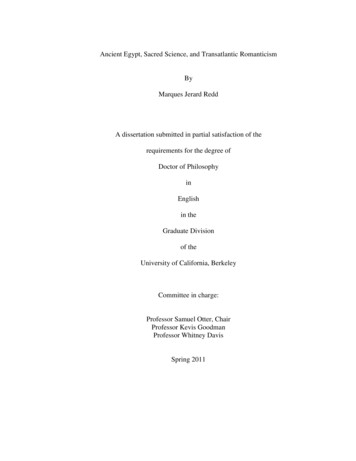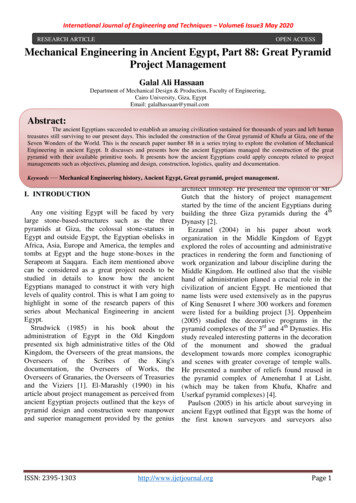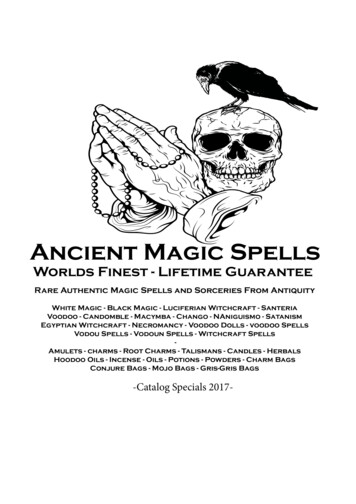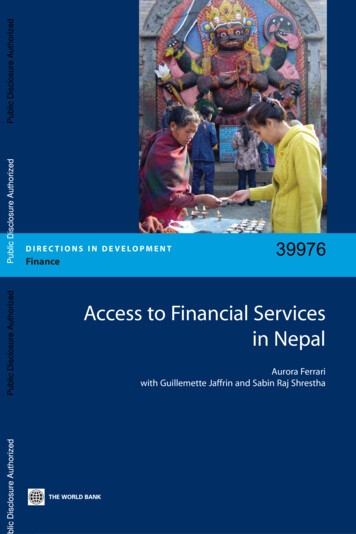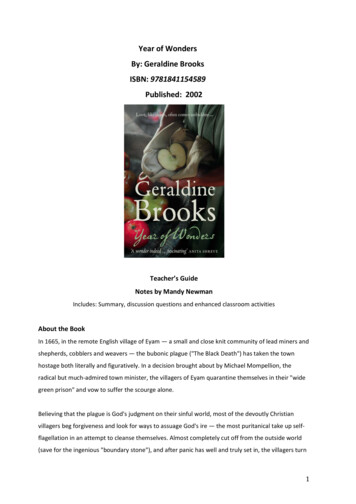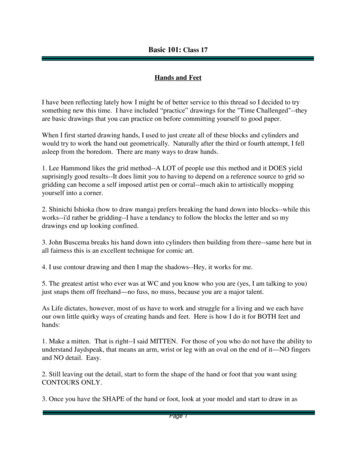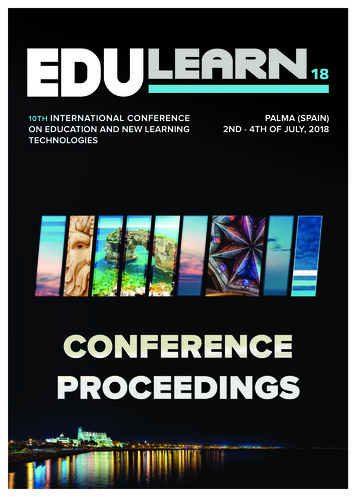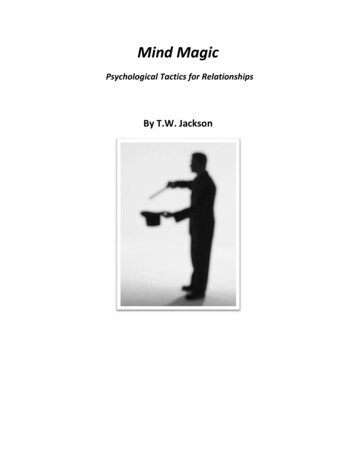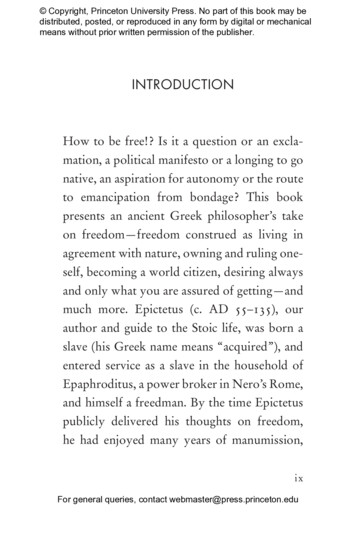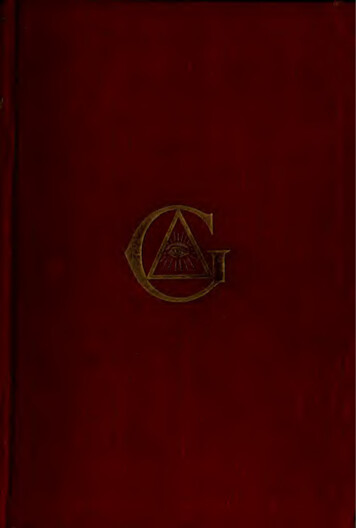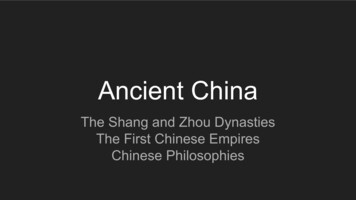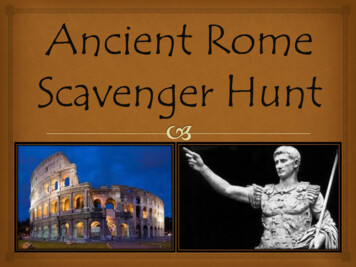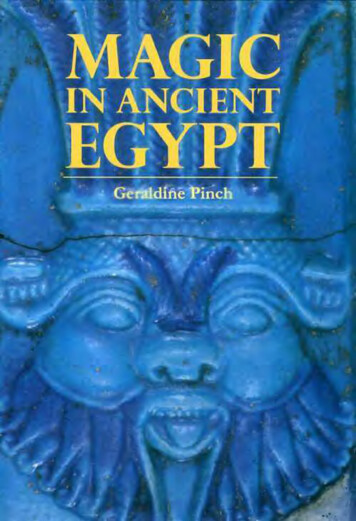
Transcription
M A G I C INANCIENTEGYPTGeraldine PinchBritish Museum Press
1994 Geraldine PinchPublished by British Museum PressA division of British Museum Publications46 Bloomsbury Street, London WCiB 3QQBritish Library Cataloguing in Publication DataA catalogue record of this tide is available fromthe British LibraryISBN O 7141 0979 IDesigned by Behram KapadiaTypeset by Create Publishing ServicesPrinted in Great Britain by The Bath Press, AvonCOVERDetail of faience plaque showing the protective lion-demon, Bes, c. ist century AD.FRONTISPIECE and BACK COVEROne of the giant baboon statues in the area of the ruined temple of Thoth at Hermopolis,I4th century BC. Hermopolis was famous as a centre of magical knowledge.
ContentsAcknowledgements7EGYPTIAN MAGIC92 MYTH AND MAGIC183 DEMONS AND SPIRITS334 MAGICIANS AND PRIESTS475611WRITTEN MAGIC6 MAGICAL TECHNIQUES767 MAGIC FIGURINES AND STATUES908 AMULETS1049 FERTILITY MAGIC12010 MEDICINE AND MAGIC13311 MAGIC AND THE DEAD14712 THE LEGACY OF EGYPTIAN tion Acknowledgements18 6Index187
AcknowledgementsNo general book on Egyptian magic can be written withoutdrawing on the specialised knowledge of many scholars, andmost particularly on the work of Professor J. F. Borghouts andhis pupils at Leiden. The recent translations of the Graeco-Egyptianmagical papyri by a group of scholars including H. D. Betz and J. H.Johnson are essential reading for anyone interested in Egyptian magic.I gratefully acknowledge the inspiration provided by a seminar serieson Egyptian magic held at Cambridge University in 1991; especially thecontributions of John Baines, Janine Bourriau, Mark Collier and JohnRay. I am grateful to Dr Stephen Quirke of the Egyptian AntiquitiesDepartment of the British Museum for his assistance with the illustrations to this book and for his helpful comments on the manuscript. Iwould also like to thank Celia Clear and Carolyn Jones of BritishMuseum Press for their work on the book.I am grateful to the Cambridge University Press and to GrahamFowden and Brian Copenhaver for allowing me to use quotations fromtheir books.
IEgyptian Magicgypt has long been considered a land of mystery and magic. Thishas led some commentators, ancient and modern, to brand theEgyptians as an irrational, morbid and superstitious race. Professional Egyptologists prefer to distance themselves from the popularimage of Egypt as the source of occult knowledge. They tend to stressthe numerous practical achievements of Egyptian civilization and thoseEgyptian writings that expound a pragmatic and cheerful philosophy oflife. This may tip the balance too far. Many of the practices described inthis book seem weird, foolish, or even repulsive from the viewpoint ofWestern rationalism, but if they are ignored our picture of Egyptiansociety is incomplete.The evidence for ancient Egyptian magic spans about four and a halfthousand years. Amulets go back as far as the early fourth millenniumBC; while magical texts occur from the late third millennium BC until thefifth century AD. Written spells are the main source material, but objectssometimes provide evidence for types of magic scarcely recorded in thetexts. These objects would have been even more useful if all earlyarchaeologists had appreciated the need to record the exact context oftheir finds. The large number of well-preserved tombs and the sheerquantity of tomb objects on view in museums have ensured thatfunerary magic has been the subject of much research. Ritual magicperformed in temples and everyday magic - the spells and rites enactedfor individuals in life - have been studied far less. These three types ofmagic were closely related and influences passed back and forth betweenthem. The insights that everyday magic can give into the personal lives ofthe ancient Egyptians make it of far more than marginal interest.The Egyptian word usually translated as 'magic' is heka. This was oneof the forces used by the creator deity to make the world. In Egyptianmyth, the primeval state was chaos. Before creation there was only adark, watery abyss known as the Nun. In the Nun existed the greatserpent or dragon Apep (Apophis) who embodied the destructive forcesof chaos. When the first land, the Primeval Mound, rose out of the Nun,the spirit of the creator had a place in which to take shape. The creatormade order out of chaos. This divine order was personified by a goddesscalled Maat. The word maat also meant justice, truth and harmony.Finally, the creator made deities and humans.E
MAGIC IN ANCIENT EGYPT1 Necklace of shell, coral,bone, ivory and glazedsteatite, with hippopotamus amulet, c. 4000BC. This amulet is one ofthe earliest examples ofEgyptian representational10These deities included the god Heka, who was depicted in humanform, sometimes with the signs that write his name on his head (figs 2, 9,11). Heka could be identified with the creator himself, particularly whenthe latter appeared in child form to symbolize the emergence of new life.Heka is also described as the ba (the soul or manifestation) of the sungod. He was the energy which made creation possible and every act ofmagic was a continuation of the creative process.
EGYPTIAN MAGICSome Egyptian deities were merely personifications of abstract concepts or natural phenomena and were never the focus of cult worship orprivate devotion. No major temples were built for Heka, but he did havea priesthood and shrines were dedicated to him in Lower (northern)Egypt. There was also a goddess called Weret Hekau 'Great of Magic'.Originally this was just an epithet, applied to a number of goddesses. Asa goddess in her own right, Weret Hekau was usually shown in cobraform. She was one of the goddesses who acted as a foster-mother to thedivine kings of ancient Egypt and she was the power immanent in theroyal crowns. The snake-shaped wands used by magicians probablyrepresent her (fig. 3).All deities and lesser supernatural beings, including the forces ofchaos, had their own heka. It was considered as much a part of them as2 Heka, god of magic(far left), stands with thegoddess Maat behindthe throne of Osiris.Funerary papyrus ofthe priestessNesitanebetisheru,c. 950 BC.3 Magician's wand in theform of a bronze cobra.From a Theban burial,16th century BC. Suchwands may represent thegoddess Weret Hekau,'the great of magic'.11
MAGIC IN ANCIENT EGYPT4 OPPOSITE Paintedlimestone stela dedicatedby a Theban artisan tothe god Ptah, c. 1250 BC.Scholars have disagreedon whether this is amagical or a religiousobject. The seven earsmay be shown tomagically compel the godto hear the donor, orserve as an expression offaith in the god'swillingness to listen.12their bodies or their names. Egyptian kings automatically had heka.People who were abnormal in some way, such as dwarfs, might also bethought to possess this quality. All the dead were credited with a certaindegree of heka. This ancient concept is comparable with the modernArabic barraka, a force possessed by many types of being and by someplaces and objects. Anything strange, exotic or ancient can be creditedwith barraka1 and it was the same with heka.Another Egyptian word for magical power is akhu. This is sometimestranslated as 'enchantments', 'sorcery' or 'spells'. Deities and stars usedakhu power, but it was particularly associated with the blessed dead. Likeheka, akhu was neither good or bad in itself. Both were powers whichcould be channelled towards creation or destruction. This book isprimarily about the ways in which the Egyptians used these powers.Some past studies of Egyptian magic have been contemptuous intone. According to one scholar 'Magic, after all, is only the disreputablebasement in the house of religion'.2 Another scholar peppered his bookon Egyptian religion with references to magic as a form of senileimbecility. This judgemental attitude was partly based on the outdatedtheory that magic and religion must be seen as opposites. Most definitions of magic concentrate on trying to distinguish it from religion. It isparadoxical that, while Egypt is famous as a source of magical knowledge, many of the best known theories about magic do not easily fit theEgyptian evidence.In his famous book The Golden Bough, Sir James Frazer defined magicas the manipulation of supernatural beings by a human who expects thatthe correct sequence of words or actions will automatically bring aboutthe desired result. This, Frazer held, was in contrast to religion, in whichhumans were dependent on the divine will and supplicated deities togrant their requests. He did recognize that the same supernatural beingsmight be involved in both magic and religion, but he saw magicians andpriests as belonging to rival groups.In Egypt, magic and religion enjoyed a symbiotic relationship. Ritualswhich would count as magic under Frazer's definition, were morecommonly performed by priests than by any other group (see ChapterFour). Magicians are often said to be distinguishable from priestsbecause they have clients instead of a congregation, and because they arenot expected to exercise any moral authority. However, this descriptionwould also cover most ancient Egyptian priests, who were paid specialists in ritual rather than moral teachers. The theory that magic is alwaysunorthodox and subversive, part of a religious and political counterculture, does not seem to apply in Egypt where ritual magic waspractised on behalf of the state for at least three thousand years.Some Egyptian priests used magic for private purposes, even when itinvolved practices that might seem blasphemous from a religious viewpoint. Egyptian spells may plead with and command a deity to carry outthe magician's desire. Other spells go as far as threatening the gods withsacrilegious acts and cosmic catastrophe. One such spell was owned by apriest named Hor, who lived in the second century BC, yet he was an
EGYPTIAN MAGIC13
MAGIC IN ANCIENT EGYPTexceptionally pious man who dedicated his life to the service of the godThoth after receiving divine visions.3 Frazer's categories of manipulation and supplication are distinct, but the same person might approacha deity in both these ways.Frazer's theory that magic involved a sequence of words and actionswhich, if performed correctly, would bring an automatic response is stilluseful, but it could be a general definition of ritual rather than just magic.The daily cult performed in every major temple in ancient Egypt mightbe considered just such a ritual. The Polish anthropologist, BronislavMalinowski, suggested that ritual action in general, and magic in particular, were resorted to when a society reached the limits of its technologicalcapability. This sounds very plausible, but the Egyptians did employmagic to deal with health problems that their medical technology wascapable of treating (see Chapter Ten). They also used magic againstforeign enemies whom they could and did defeat with their militarytechnology (see Chapter Seven). Parallel practical and ritual action aimedat the same problem seem characteristic of Egyptian culture. These twotypes of action were obviously expected to work in different ways, orperhaps on different planes of existence.Malinowski argued that magic is usually aimed at solving a specificproblem, while religion is, or can be, an end in itself. Another anthropologist, Mischa Titiev, defines religion as 'calendrical' and magic as 'critical'.4 In other words, religion is concerned with regular rites carried outon behalf of the community, while magic is mainly performed forindividuals at times of crisis. The primary concern of the state-runtemples of ancient Egypt was to benefit society as a whole, not to cater tothe religious needs of the individual. This benefit was achieved by meansof the daily ritual and through a calendar of religious festivals. However,the principle of crisis was built into Egyptian theology. Each setting ofthe sun was a cosmic crisis which required ritual action. These ritualswere often very similar to acts of private magic and they were performedby the same type of priest who might work magic for individuals.It is true that in the private sphere many Egyptian magical practiceswere associated with standard life-crises, such as the dangers of childbirth, or with sudden disasters, such as an accident or an infectiousdisease. Magic may be a form of 'crisis management', but it was not onlyresorted to when a crisis had already happened. A high proportion ofEgyptian magic was prophylactic. It aimed to prevent trouble by settingup a magical defence system for an individual, a group or a place.The wishes of an individual can conflict with the welfare of society asa whole, but examples of 'anti-social' magic are quite rare in the Egyptianrecord before the period of Roman rule. Many cultures have dividedmagic into acceptable and unacceptable types. When unacceptablemagic is mentioned in Egyptian sources it is usually attributed toforeigners.In medieval Europe, a distinction was made between Demonic andNatural Magic.5 The former relied on invoking demons to carry out themagician's commands. Demonic Magic was held to be bad because14
EGYPTIAN MAGICdealings with such beings inevitably led to the moral corruption of themagician. Natural Magic, on the other hand, simply utilised naturalphenomena, such as astral energy, and could therefore be used byChristians (see Chapter Twelve). Most ancient Egyptian magic wouldhave to be classed as Demonic, since it invoked all manner of supernatural beings including the fearsome inhabitants of the underworld (see5 Wooden figure of aguardian demon, coatedwith black resin, c. 1295BC. Such beings were notevil powers, but servantsof the good god Osiris.15
MAGIC IN ANCIENT EGYPTChapter Three). In Egyptian theology, however, few of these beingswere regarded as evil, so communication with them involved no spiritualdanger. A type of Natural Magic, partly based on th
Written spells are the main source material, but objects sometimes provide evidence for types of magic scarcely recorded in the texts. These objects would have been even more useful if all early archaeologists had appreciated the need to record the exact context of their finds. The large number of well-preserved tombs and the sheer quantity of tomb objects on view in museums have ensured that .
